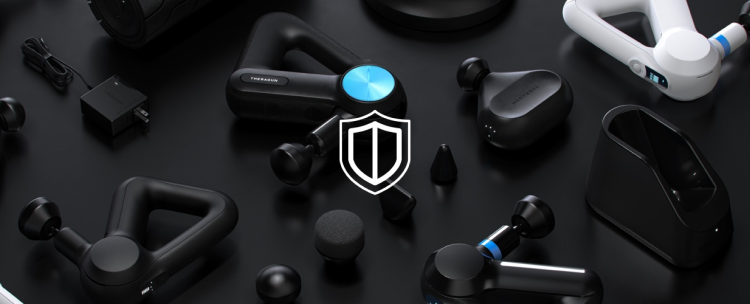Authors: Therabody Scientists: Tim Roberts, MSc; Rachelle Reed, PhD, MS, ACSM-EP; Kyle Silvey, PhD, CSCS; Michelle Darian, MS, MPH, RD, LDN
Do your facials include a lymphatic massage? Or have you seen ads for lymphatic drainage leggings? Lymphatic drainage has garnered a lot of buzz recently, yet the lymphatic system it’s referring to isn’t as recognizable.
The lymphatic system is integral to overall health and specifically critical to immune function. It also serves an important purpose in maintaining proper fluid balance throughout the body. If your lymphatic system isn’t running optimally, fluid can build, and you may experience swelling and inflammation. Oftentimes, this fluid pools in your face (leading to a puffy appearance) or doesn’t circulate optimally, leading to soreness in your legs. Not only can it be aesthetically frustrating — it can also impact how quickly you recover from workouts.
Let’s break down what you need to know about the lymphatic system and science-backed therapies to keep it running smoothly.
What is the Lymphatic System?
The lymphatic system is referred to as the “second circulatory system." It’s composed of a network of small vessels that run throughout the body, nodes that are like filtration systems containing immune cells, and organs like the thymus and spleen. [1]
Together, this system transports lymph. Lymph is a clear fluid that contains water and white blood cells (in addition to some proteins and fat). It’s basically the fluid that’s left over after the normal, constant exchange of nutrients and waste between blood vessels and cells.
This excess fluid accumulates, causing a swollen or puffy appearance. Lymphatic vessels then collect this lymph — in turn, draining excess fluid from tissues. When working properly, the lymphatic system helps reduce swelling, improve circulation, and enhance the skin’s overall appearance. [1]
The lymphatic system also transports some dietary fats and transfers immune cells to lymph nodes to fight infection, but for the purposes of this article, we’ll focus on its role in fluid balance. [1]
Lymph fluid can build up, and the body doesn’t have an internal mechanism to kick off this draining process. So, fluid doesn’t always get transported efficiently from body tissues to the lymph vessels, leading to swelling, puffiness, and discomfort.
What Causes Lymph Build-Up?
Unlike the circulatory system — which is powered by a pumping heart — there’s no innate stimulant of the lymphatic system to actively move fluid through its vessels. [2]
Instead, the system needs external stimulators to help move fluid into and around the lymphatic system, for example, exercise or a massage. When we move our muscles, like during exercise, the contractions help to squeeze the vessels, moving fluid through the system.
Exercising is one important way to prevent fluid from pooling. And since there’s no internal “pump," lymph is prone to pooling if the system isn’t functioning optimally.
This lymph buildup can be a result of many factors, some of which are medical and include infections, venous insufficiency, and even heart failure. [3]
Certain lifestyle factors can also cause lymph to pool in tissues. This pooling is a result of many factors, including too little movement (or improper recovery from movement), namely:
- Poor Recovery from Exercise: Exercise, especially high-intensity or weightlifting workouts, causes micro-tears in muscles. The lymphatic system plays a key role in cleaning up the metabolic waste from this, but poor lymph drainage can trap waste, causing prolonged soreness, inflammation, and fluid retention (particularly in the legs). [4]
- Insufficient Sleep: Not sleeping enough — or disrupted sleep can affect fluid balance and lead to puffiness and lymph buildup around the eyes. Sleeping on your stomach or side can also cause facial lymph buildup as gravity pulls the fluid downward (which is why your face may look especially puffy in the morning). [5]
- High Stress Levels: Chronic stress increases the hormone cortisol and may affect fluid accumulation and circulation. This may also cause your face to appear round and puffy. [6]
- Slouching Posture and Prolonged Sitting: Bad posture, especially tech neck, can impede lymph flow from the face down to the neck, creating fluid buildup. Similarly, sitting all day long can lead to swelling in the lower limbs. [7]
- Aging: Like most body systems, the lymphatic system is also prone to age-related changes. This means as you get older, the system may be less efficient at circulating lymph. [8]
The good news is, you can manually stimulate the lymphatic system by using lymphatic drainage techniques.
How to Promote Lymphatic Drainage
Lymphatic drainage refers to the efficient movement of lymph from tissues into the lymphatic system. [1]
Foundational lifestyle habits, like physical activity and hydration, can promote lymphatic drainage. Physical activity initiates muscle contractions, which encourage lymph flow and circulation. And staying properly hydrated helps maintain lymph fluidity.
Technology can also help. Varying tech leverages the science behind the body’s natural restorative processes to promote healing. Some effective therapies include:
- Massage: Rhythmic pressure helps physically stimulate lymph flow and move lymph efficiently in the body. [9]
- Static Compression: Compression garments (like socks are bands) prevent stagnation and pooling of lymph. [10]
- Pneumatic Compression: This is sequential compressive therapy generated by a device. [11]
- Vibration: Vibration therapy applies oscillating waves to the body, which activate lymph vessels and improve circulation. Overall, this helps move lymph and promotes waste elimination. [12]
- Contrast Therapy: Alternating between heat and cold therapy helps dilate and constrict blood vessels, mimicking a “pumping" effect that encourages lymphatic flow, reducing swelling and puffiness in addition to aiding recovery. [13]
The benefits of lymphatic drainage are wide-ranging, from improved skin health to promoting and enhancing recovery.
Lymphatic Drainage Promotes Skin Health
The lymphatic system affects the appearance of skin.
“If you have excess puffiness or swelling [in the face], it’s due to excess lymph fluid," says Therabody Scientific Advisory Board Member and dermatologist Dr, Neera Nathan. Lymph could accumulate from poor sleep, stress, or even age.
Lymphatic drainage techniques can help reduce puffiness, improve circulation, and enhance overall skin appearance. [14]
Cold Therapy Helps Reduce Facial Puffiness
Cold therapy is especially effective at combating facial puffiness. “Overall, cold therapy is really excellent because it constricts blood vessels. When you constrict blood vessels, that leaky fluid that causes puffiness or lymph gets removed," says Nathan. “Cool compresses are great. Devices with a cool tip [like the TheraFace Depuffing Wand] can be used to depuff and help increase lymphatic drainage."
And it doesn’t take long to see an improvement. Just a few minutes of treatment at appropriate temperatures can have a noticeable impact. Read more about the science behind cold and health therapy and what temperatures are best for both here.
Vibration Therapy (A Form of Massage) Helps Improve Circulation
Vibration therapy is a specific type of massage delivered by a device that helps improve circulation and, therefore, the flow of lymph. [12]
Gentle vibrations stimulate muscle contractions and move lymph through vessels. Vibration also relaxes muscles, and the release of tension can ease congestion in the lymphatic system.
Vibration therapy can also be used on the face to reduce puffiness. The TheraFaceTM Mask encompasses tension-relieving vibration therapy to boost circulation in the face and improve the skin’s appearance.
Leveraging the Lymphatic System Can Enhance Recovery
As mentioned earlier, high-intensity exercise and the resulting recovery processes can lead to lymph buildup. If that lymph continues to pool, pain and swelling can further hinder your recovery and prevent you from getting back to your next workout as soon as possible. [15]
But technology can help leverage the mechanisms of the lymphatic system to clear any buildup swiftly and help you recover faster.
Pneumatic Compression Therapy Stimulates the Lymphatic System
Pneumatic compression boots stimulate both the circulatory and lymphatic systems of the legs.
This garment is worn, and a pump precisely controls the amount of pressure and the intervals at which it’s delivered. Pneumatic compression creates a gradient so blood and lymph flow in the right direction, increasing the filtering of waste products from the blood into the lymph and then into the lymphatic system. [11]
Pneumatic compression boots can help recovery by decreasing swelling in the legs and feet, alleviating soreness, and decreasing muscle stiffness. [16]
Now, it’s easier than ever to reap the benefits of this therapy at-home with devices like Therabody’s JetBoots®. “JetBoots technology allows us to control swelling, boost circulation and lymphatic drainage, and help with muscle fatigue and DOMs post-treatment or in the comfort of your own home," says Therabody Scientific Advisory Board Member Dr. Dan Giordano, PT, DPT, CSCS.
Cold Therapy Reduces Inflammation and Swelling Formation
Cold therapy targets blood flow and lymphatic drainage across the body — not just facially.
Cold therapy feels good on muscles post-workout, and it helps reduce inflammation by narrowing blood vessels and decreasing blood flow to any treated area. Constricted blood vessels help remove excess lymph that’s causing any swelling, discomfort, and impaired mobility. [17, 18, 19]
Therabody’s RecoveryThermTM Cube provides instant and consistent cold (and heat) therapy in a handheld device that can be used anywhere on your body. This contrast therapy is an effective way to support recovery with science-backed temperatures that are never too hot or too cold.
Key Takeaways
- The lymphatic system plays a big role in fluid balance in the body — sweeping away built-up waste from the blood.
- When working properly, the lymphatic system helps reduce swelling, improve circulation, and enhance the skin’s overall appearance.
- Sleeping poorly, intense exercise, stress, posture, and aging can lead to lymph buildup in tissues and swelling.
- As the lymphatic system has no “pump" to keep things moving, technology can help stimulate the lymphatic system to run more efficiently. Cold therapy, vibration, and pneumatic compression are all science-backed ways to promote lymphatic drainage.
References:
- https://www.ncbi.nlm.nih.gov/books/NBK513247/
- https://training.seer.cancer.gov/anatomy/lymphatic/components/
- https://www.ncbi.nlm.nih.gov/books/NBK537239/
- https://pubmed.ncbi.nlm.nih.gov/28817412/
- https://pmc.ncbi.nlm.nih.gov/articles/PMC7698404/
- https://pubmed.ncbi.nlm.nih.gov/24798553/
- https://pmc.ncbi.nlm.nih.gov/articles/PMC9219739/
- https://pmc.ncbi.nlm.nih.gov/articles/PMC6738433/
- https://www.physio-pedia.com/Manual_Lymphatic_Drainage
- https://journals.lww.com/aswcjournal
- https://www.ncbi.nlm.nih.gov/pmc/articles/PMC3629206/
- https://pmc.ncbi.nlm.nih.gov/articles/PMC4560014/
- https://pmc.ncbi.nlm.nih.gov/articles/PMC3633882/
- https://pmc.ncbi.nlm.nih.gov/articles/PMC10045879/
- https://pmc.ncbi.nlm.nih.gov/articles/PMC4681911/
- https://pmc.ncbi.nlm.nih.gov/articles/PMC150384/
- https://www.aao.org/eye-health/tips-prevention/bags-under-eyes
- https://pubmed.ncbi.nlm.nih.gov/11302460/
- https://pubmed.ncbi.nlm.nih.gov/16558673/







